Probably the first thing any of us will notice in a post-disaster scenario is the lack of electrical power. The second thing we will most likely notice is that there isn’t any water. We’ll go to the sink, expecting the water to come out of the faucet, like it always does, and nothing will happen. For many, that will be the moment they wake up and realize that the brown stuff really has hit the rotary air movement device.
Water is one of our top survival priorities, beaten out only by the ability to maintain our core body temperature. Yet it is often overlooked in our day-to-day lives. We are so accustomed to having water at our fingertips, that most people don’t have any idea where to get water, other than bottled water, in the case of an emergency which shuts down the city water.
Yet most of us have a number of water supplies readily available, within walking distance of our homes. We also have clean water in our homes, ready for our use. All we have to do is find a way to access it.
Your Water Heater
The water heater in most homes consists of a 30 to 50 gallon tank, with a heating element inside. This tank is always full, even though you may not have water flowing through your home’s pipes.
Water in the water heater won’t flow out of your faucet, without the water pressure from your municipal water authority.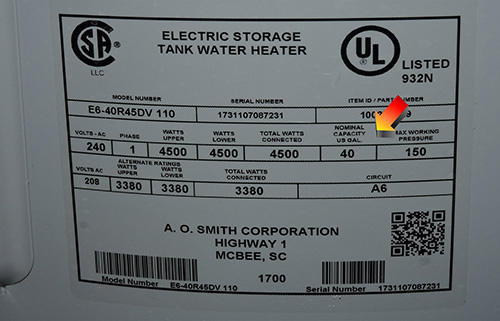 But the water is still there and not hard to access. You can tell how much water your water heater holds, by checking the label.
But the water is still there and not hard to access. You can tell how much water your water heater holds, by checking the label.
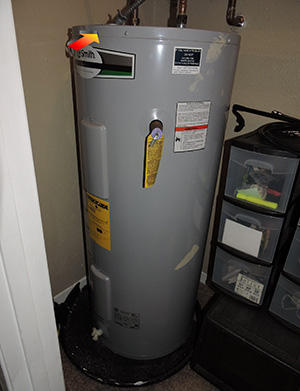
The water heater can be located in a number of places. Homes with basements will usually have the water heater located there. Homes and apartments which do not have basements will usually have the water heater located in a closet. Mine is located in my office closet.
Related: How To Heat Your Home Without Electricity
Safety First
Before draining the water out of your water heater, you need to ensure that it is turned off and the water has had time to cool. The water inside your water heater is usually at about 140°F, which is hot enough to cause second-degree burns.
To turn off the water heater, you’ll first need to determine if it is a gas or electric water heater. The water heater above is an electric one. There is wiring, inside a metal conduit, connected to the top to provide power (note the arrow).
If it was a gas water heater, it would have a gas valve and control, mounted near the bottom, something like what is shown in the photo below. Please note that these can vary considerably in their appearance. There will always be a knob on the gas water heater’s control valve, allowing you to turn it off. In the photo above, this is the black knob.
There will always be a knob on the gas water heater’s control valve, allowing you to turn it off. In the photo above, this is the black knob.
Electric heaters will not have any sort of control or switch on them, which allows them to be turned off.
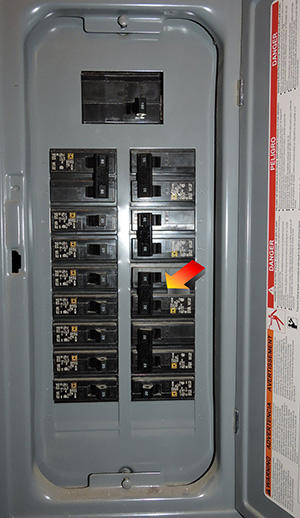
Instead, you’ll have to turn the water heater off at the breaker box.
In most cases, the water heater requires 240 volts to operate. In order for your home’s electrical system to provide that will require a double breaker, such as the one pointed out in the photo above. There are a total of five double breakers in this box, easily identified by the longer switch handle, which connects the two sides of the breaker together. The others are for the air conditioner, clothes dryer, air conditioning condenser unit and HVAC air handling unit.
It will take a good 12 hours or longer for the water to cool, once the power has been turned off. The water heater is insulated, so the water will retain the heat for a long time. If your water heater has a blanket around it (it will be soft, rather than just metal), remove it, so the water can cool more rapidly.
Related: Storing Water for When Disaster Happens
Draining the Water
There is a drain valve located near the bottom of the water heater, as shown in the photo below. The valve itself may be plastic, as shown, or metal. You can also see that the water heater is sitting in a pan, which is intended to capture spills and leaks.
For newer homes, building code requires that the water heater be on a stand, raising it up off the floor. But in older homes, like mine, this was not done.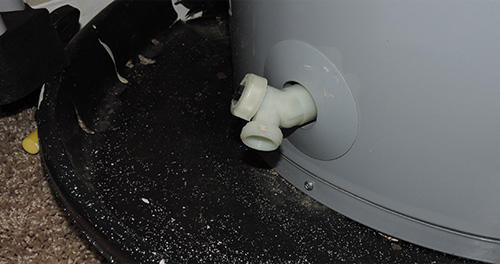 Connect a standard garden hose to the drain valve and put the other end into a clean pot or bucket. Please don’t use the bucket you use for cleaning the floor, this is clean water and you want it to stay that way. Open a sink faucet somewhere in the home, preferably on the second floor, as far away from the water heater as possible.
Connect a standard garden hose to the drain valve and put the other end into a clean pot or bucket. Please don’t use the bucket you use for cleaning the floor, this is clean water and you want it to stay that way. Open a sink faucet somewhere in the home, preferably on the second floor, as far away from the water heater as possible.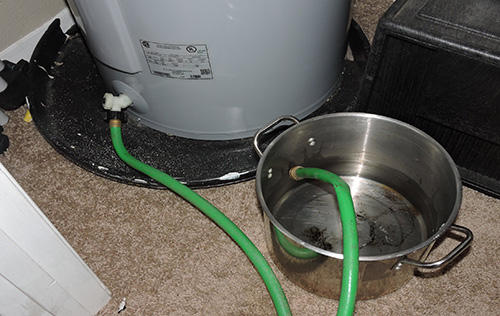 Open the valve and allow the water to flow. Even though the top of the pot is higher than the valve, the water will flow, because the water level in the tank is higher than the top of the pot. Be ready to shut the valve off quickly, when the water gets near the top of the pot.
Open the valve and allow the water to flow. Even though the top of the pot is higher than the valve, the water will flow, because the water level in the tank is higher than the top of the pot. Be ready to shut the valve off quickly, when the water gets near the top of the pot.
You will notice when the water level gets near the bottom of the tank, as the water will flow more slowly. When it reaches the point where the water inside the tank is at the level of the top of the pot, the water will stop flowing. At that time, you will need to replace the pot with something shorter, such as a baking dish, dumping the water from the baking dish into something larger, like this pot.
A Bit More Water
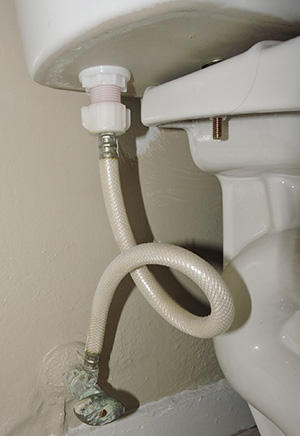
There is a bit more water hiding in the home’s pipes, over and above what’s in the water heater. To get to it, you need to find the lowest water access point in the home. This will be a toilet fill line, on the ground floor (or basement) of your home.
Even though this is water for your toilet, it is still clean water. In fact, it’s the exact same water that comes out of the kitchen and bathroom faucets. Close the valve and disconnect the short hose from the toilet tank. Place the end of the hose in a container and then open the valve. The water in the pipes will drain out, by gravity, just like it did from the water heater. You may get as much as two gallons of water this way.
The water in the toilet tank is also clean water, although the water in the toilet bowl is not. There will be three to four gallons of water in the tank, depending on how old your toilet is. You can scoop out the water from the tank and use it for washing. I would not use it for drinking, just for safety’s sake, even though it is probably clean enough to drink.
You may also like:
Is it Safe to Drink Old Stored Water?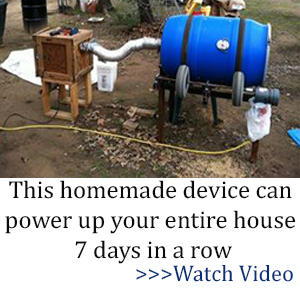
How to Build a 44-Day Stockpile for Only $2.40 a Day (Video)
How to Can Water for Emergencies
7 Super Cheap Foods To Stockpile That People Usually Throw Away
How to Build a Water Purification System in 10 Minutes

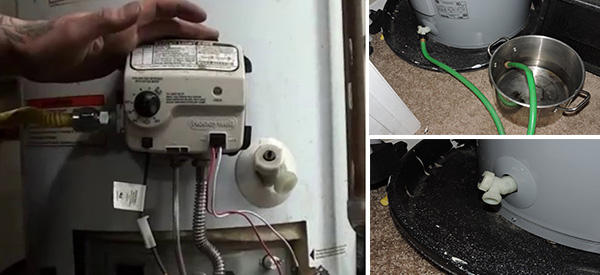













I’ve always heard you should not drink water from the hot water tank due to the possibility heavy metals can collect in the tank. Truth or myth?
The water in the tank is clean, but if it’s old/degraded how can you make the water safe for drinking?
Pet peeve! It’s just a water heater. “Hot” water doesn’t need to be heated.
thank you. I don’t know how we made this mistake. I’ve just changed it.
My Old heater was Scaled up with lime but it was still leafless – so I kept it in place and in series with a new heater – The old tank became a tempering storage tank taking water 55F to 65F – That was a big saver and the old but good tank stayed in place!
That worked for me as well, until the tank finally developed a leak… Water came in from the road around 40F in the winter, and tempered to the fieldstone foundation basement temperature of 55F to 60F by the time it made it to the hot water tank. Much the same as a heat pump which acquires heat from the ground and groundwater in the field.
Hi Fish, I told them it was a Water Heater also! Another thing people get wrong is pronouncing POTABLE Water.
It is not POT able, but pronounced as: ” PULL Ta BULL ”
If people don’t believe me, they can contact the Central Pollution Control Federation, or the Sanitary Water Board.
Old hot water tanks were made of copper, and we were told not to drink from them because of copper poisoning, now most of your pipework is in copper ( for hot or cold water) but your water heater is most likely made from black iron,which is a lot cheaper, and is why they only last about 10 years.
It is a cold water heater,
Why would you heat hot water?
Just a sidenote: If your hot water tank is in a basement, you can also get up to a few more gallons by turning on all hot water faucets in the house, allowing the water in those lines to easily drain back through the hot water tank when you are draining the water from the tank.
Before doing any of these things turn off the water source to your house at the meter. If you do not, you may be drawing contaminated water into your ‘clean’ water in the tank. This applies mainly in earthquake country where pipes in the system may be fractured and allowing contaminates.
If the electricity is off and you have an electric water heater, you don’t have to turn off circuit breakers at the service entry box. You only have to do that if you have an expectation that the electricity will come back on.
I would filter the first couple of gallons of water out of the water heater through a coffee filter or some other filter to remove any possible sediment from the bottom of the tank.
If, when replacing your water heater, you find you have enough room, I would purchase the largest size water heater that will fit in the space available. The cost of installation is no more for a larger water heater than a smaller one. The cost differential, at least in SoCal, between a 40 gallon water heater and a 50 gallon hot water heater, amortized over the life of the heater is minimal. That gives you whatever extra amount you buy over your present water heater as water storage. Ten extra gallons of water will last two people five days. That five days just might be critical.
I don’t care how they tout a tankless water heater as superior to a tank water heater, as a preppier, you are replacing a 40 or 50 gallon water storage vessel for no water storage. I always recommend to any one interested that they not replace their tank water heater with a tankless model.
As a response to Debbie’s question about heavy metals, Do you use hot water to wash your toothbrush? Do you always use cold water for drinking purposes especially a hot drink if you are in a hurry? Wo you wash your face with hot water? Do you wash dishes with hot water?
If your supplied water system has sufficient heavy metals in it to be harmful, you have been ingesting them since you moved into that house. If you are concerned about them, you should be filtering all the water that enters your home. It isn’t like panning for gold. They don’t “sink to the bottom” of your water heater. Perhaps if you had a vacation home that you only visited a couple times a year that might be a serious concern but the water in your water heater circulates. Cold water enters at the top of the heater and sinks to the bottom. Hot water exits the top of the water heater. The every time you open a hot water faucet you are circulating the water in the tank. Heating causes calcium to precipitate out of the water and that is generally what you get at the bottom of your tank. If you have heavy metals, they are in a fine colloidal suspension and would only precipitate out if the water sat in the tank for an extended period of time. If they precipitated out easily, they wouldn’t be in the water to begin with.
Just one small correction, Chuck. While cold water does indeed enter at the top of the water heater it just doesn’t “sink” to the bottom. If it did that then all the effort made to heat the water would be in vain and you wouldn’t have much hot water to have those nice long hot showers. The cold and heated water would very quickly mix. When the cold water enters at the top of the tank it is forced to the bottom of the tank by a tube or pipe made either of plastic or metal. This pipe goes almost to the bottom of the tank and is called a
“dip tube”. Its purpose is to force the incoming cold water to the bottom of the tank instead of negating the purpose of the water heater and letting the cold and hot mix too quickly.
Chuck, we live in a rural area with our own well (tested regularly). We have a large storage tank at the entry point (garage) then a full-house filter for sediment. At the kitchen sink we have a drinking water dispenser with the water going through an RO filter system. No, I never use hot tap water to hurry up hot beverages.
I’ve heard the comments about heavy metals since I was a little kid. I’ve never asked anyone if was fact or fiction. Just curious because, as you can tell, I feel strongly about clean drinking water!
Armin: You are absolutely correct. My aging brain completely forgot about the dip tube taking the cold water to the bottom of the tank. Thanks for the correction.
In the last twenty years I have been having my water heater replaced by plumbing guys and not doing it myself. I used to be able to rassle a worn out water heater off the pedestal by myself, but it had gotten to the point where my wife insisted doing it myself was a danger to me so for the sake of domestic peace I went professional installation — plus she also was 100% correct. With the added “green” water heaters, 40 gallon and 50 gallon water heaters are no longer available in the PDRK. They now are 38 gallon and I think 46 gallon water heaters. The extra space is take up by mandatory insulation.
With the high quality water we have out here water heaters only last six years, the guarantee period. I am convinced that they have a programmed chip in them that makes them expire one week after the warranty expires and always on a Saturday night unless you are going away for the weekend then they expire on Friday night and leak all weekend. cjr4271@att.net.
Debbie: Your regular well water testing should provide information about heavy metals in your drinking water. If that is not part of your regular report and you have reason to suspect that your well might contain heavy metals, I would certainly have the testing company add that test to the ones that they now perform.
With our water heaters only lasting six years and a day or so, heavy metal accumulation doesn’t seem like a problem to me. Of course, I could be blissfully living in ignorance.
I met a gentleman who lives in what is called “Gold Country” here in the PDRK. That is the region of the Sierra Foothills where gold was mined in the 19th century and amateurs still pan for gold on weekends. He told me there had been a small earthquake about twenty miles away and immediately following the earthquake a couple of things happened. One, an artesian well on his property stopped flowing and two and more importantly, his deep well developed such a high copper content in the water that it was unpalatable and actually dangerous to drink. They had to put in a special limestone filter to eliminate the copper from the water.
I had never considered that an earthquake could affect water supply. It makes absolute sense when one thinks about it, but it was a detail that just never occurred to me.
Now it may be with the passage of enough time and with sufficient rain the gentleman’s artesian well will start to flow again and the copper vein that was exposed to his well may well dissolve away but he may not be able to wait 500 or a thousand years for that to happen. Or, another earthquake in the area could resolve the problem for him.
The take away is that even if you have your own deep well, and live in earthquake country, the water may suddenly become unavailable to you if the major natural event you are prepping for is an earthquake on the scale of the New Madrid earthquake in 1812 which made the 1906 earthquake in San Francisco and subsequent earthquakes here in the PDRK look like a heavy truck passing by.
Caution: Legionella bacteria tend to grow in the lower temperatures at the bottom of water heater; such bacteria can cause a form of pneumonia. The organism is generally transmitted when people inhale contaminated water droplets from whirlpool baths, showers or building air conditioning systems.
A water temperature of 120°F does not kill the Legionella bacteria; a hot water temperature of 140°F is required at which Legionellae dies in 32 minutes. Hence it is recommended that the water heater be set at a safe hot water temperature of 140°F. The Legionella disinfection range is 158 – 176 °F.
I didn’t know much about Legionella, FVP, so I looked it up (this website is forcing me to look up a lot of stuff I didn’t know about before…maybe a good thing :)). The bacteria is common In many environments including soil and aquatic systems. It’s NOT transmissible from person to person. Most people exposed to it do NOT become sick. Those most at risk are people with compromised immune systems and the elderly therefore it shows up mostly in hospitals and nursing homes. The bacteria typically exists in nature in low concentrations in places like groundwater, lakes and streams so it’s around us all the time. If you want to control the growth of the bacteria keep your cold water below 25 C (78 F) and hot water above 51 C (124 F). At these temps it will still survive but not multiply. Of course the higher the water temp. the faster it dies. Above 70 C (158 F) it dies almost instantly. I don’t think it’s a really good idea to run your water heater at that high a temp. for the reasons many others have given. Don’t know if water heaters even go up that high. For one thing it would be BLOODY! expensive to run your water heater at that temp. all the time and then the very real danger of serious burns if you’re not careful. And here’s the important part. Legionella responds VERY well to chlorine. WHEN USED AT SPECIFIED LEVELS FOR WATER DISINFECTION, THE REACTION OF CHLORINE WITH WATER IS NOT A MAJOR HEALTH CONCERN FOR HUMANS. And I’ve also read somewhere, but I can’t find it again, is that the human digestive system is very easily able to deal with chlorinated water without ill effect. I don’t know what each of your respective cities uses to disinfect your water supply but where I live they use chlorine and every once in a while the water has a bit of a stronger taste of chlorine in it. Not really disagreeable but you CAN taste it. I don’t know if any cities are still using fluoride to disinfect their water supplies but my town isn’t. There was a big hub bub about fluoride in our drinking water a few years back. So if you think you have a legionella “bloom” happening in your water heater, to my way of thinking, if you want to get rid of legionella; firstly fill up some containers with clean drinking water (also enough water to throw down the toilets for 24 hours) so you have water to drink for at least 24 hours and maybe throw in a little extra chlorine in those containers. A LITTLE extra! Then throw enough chlorine into your water heater to raise the chlorine level above 50 ppm. I’m sure you could use the same stuff you use to chlorinate a swimming pool. And you guys are very creative and very smart. I shouldn’t have to list all the methods to introduce chlorine into your water heater or your whole house water system. There have to be numerous ways to do it. Might take a little work but it CAN be done by each and every one of us. You guys are smart enough to figure them out. It’s called hyperchlorination and if you want, you can set up your water system in your house to do it annually, without tearing everything apart each time.Then after the introduction of quite a bit of chlorine into your water heater crank the almighty crap out of the water heater thermostat and set it as high as you possibly can. For 24 hours. Like I’ve said, I don’t know if water heaters go up to 178 F so you may as well crank it as high as it will go. For 24 hours. DON’T TURN OFF THE SUPPLY SIDE! After 24 hours, voila! no more legionella. Flush the system. Drink the water. Enjoy. 🙂 This is for you, Chuck. The good LCC Chuck not the bad Chuck. LOL! How many chucks could a wood chuck chuck if a wood chuck could chuck chucks? LOL! Sorry, couldn’t resist. I digress. Chuck, you mentioned something about stepping into a tub that was too hot and getting burned. I offer one solution. I like nothing better than to soak for a long time {does my back wonders :)} in a VERY hot tub. Hot enough so that the sweat is running like rivers from my brow. I use the “boil the frog” method and for me at least works fine without burning me. I don’t turn green. LOL! Get into an empty tub. Start the water fairly warm but not uncomfortable. As the tub fills, slowly keep increasing the temp. until at the end you’re sitting in a tub full of steaming hot water without discomfort. HEAVENLY! 🙂 One of the few ways I can pamper myself without breaking the bank.
This article would apply if you still have a “tank” water heater. But if you have a “tankless”, like I do (more efficient), then there is no tank in the water heater to hold that water. But fortunately, I have a well, and am not dependent upon “city water”; and with a portable 220V 6000W generator, I can run my well pump, which also has about a 50 gallon well tank, and it provides the pressure too.
In time of extreme desperation another source of water is the water line in front of your house. Dig down to the line. Drill a hole in the line and insert a straw. It won’t last forever but it will gain you a few days of clean water.
If you haven’t kept up with “flushing” you hot water tank. Should be done every 6 months or so, depending on your water source. Most homeowners never do this. There will usually be a build up of sediment in the bottom of the tank. Sometimes so much that the bottom valve will be blocked.
Since water is a necessity clean sources can be very important. I have 2, 5 gal containers and 2, 2 1/2 gal containers for a quick 15 gal. I water plants now and then from those and refill with fresh cool water.
Good reminder of where water can be found.
Every one should have a supply of “Life Straws”. Never used one yet but supposedly you can drink swamp water out of one of them. I’m in Nebraska where we are in the middle of the worst natural disaster in over 100 years. Hundreds of bridges washed out. Limited travel in much of the state. We haven’t had District water in over a week because a main 12″ line washed out and will be out of commission for weeks. We are having a “mini-EOTWAWKI”. Fortunately got electricity back within a day.
When I read FVP’s comment I wanted to check his data. While the fire department will tell you not to set your water heater at such a high temperature, a water safety website recommends a setting of 140°F for the reasons FVP stated.
The fire department recommends a much lower setting for burn safety, especially if you have small children or elderly in your household.
Hot water, according to the fire department, is very dangerous for a small child. A burn on an adult that would be minor becomes major on a child because the same size burn on a child equals a larger portion of their body mass. In addition, if a child needs skin grafts as a result of a burn, then the child will need a series of skin grafts as they mature and get bigger because, according to the fire department, grafts either do not grow or do not grow at the rate a child develops and grows.
Elderly, according to the same source, have a tendency to not pay attention to the setting on the shower or bath and get into a tub that is too hot for them and get burned. 120°F will burn them but takes longer to reach third degree burns. 140°F water burns to third degree much quicker. Burns are more life threatening to an older person because their other body functions, lungs, liver, kidneys are oftentimes not operating at 100% and you need those organs to be operating at 100% if you are going to survive extensive third degree burns.
As a personal note, I am an aficionado of hot springs and especially Japanese hot springs. Forty-one degrees C is about the hottest I can stand which translates to roughly 106°F. Some hot springs will have temperatures as hot as 45°C which is roughly 113°F and those always have a warning sign on them. I notice that even Japanese don’t linger in the 45° pools long. So you can see that 140°F is pretty darned hot. I doubt that one would be able to keep their hand in water as “cool” as 120°F.
LCC. Your mention of temperatures reminded me of a bath thermometer my mother had when I was a little child. It was an old mercury thermometer set in a wooden frame so it floated in the bathtub. It had marking showing actual temperatures but the were in marked section for too cold, cool, tepid, warm, quite warm, and too HOT! .
Moms favorite was quite warm at 106F. It hurt me so mom would soak till it was between 97 and 100. That was warm but comfortable for me. Then I could get in the tub and she’d wash me and we’d get out. Sweet memory. When I was turning 4 we moved to a home with just a shower. By then I was bathing myself.
I don’t know when the thermometer broke but mom said she missed it. She had always let it float in the tub while it was filling. She said she’d purchased it long before the war.( WWII) I’ve never seen another like it.
Thanks for a sweet flashback to early childhood. I bet at 106 the hot spring was a good temperature for a relaxing soak.
ClergyLady: Your post jogged a memory from the dim past. I am pretty sure my mother also had such a thermometer that she used for my two younger brothers. She probably used it for me but that is just too far back. I think those memory bits have been written over. Of course, being a strait-laced lady who came to maturity in the 1930s, she did not bathe with my brothers but she used it to make sure the water was not too hot.
Our hot water temperature varied widely. We had a coal burning furnace and a bucket-a-day. The coal burning furnace had a hot water jacket in the furnace where water circulated around the firebed. Depending on hot cold it was outside, the water could be steam. We tried to avoid that because it stressed the lines and oftentimes would cause a leak. Nothing like trying to patch a steam-hot line. I was too small to help much but I did learn some very colorful language watching my father. He was a pipefitter at an oil refinery, so working with hot lines was nothing new for him and I suppose colorful language was not unknown either.
The bucket-a-day was my summertime responsibility. It was supposed to burn a bucket of pea coal a day and it too had a hot water jacket around the inside of the stove. If I let it go out, usually the water would be quite hot before I got the coals to a point where they could be banked. So our hot water temperature ranged from steam to pretty darned cold if the furnace happened to go out overnight because my father didn’t bank it correctly. That was his responsibility until I got old enough to know how to do it without putting it out and then it was my job.
Thanks for the memory jog. I too don’t know what happened to that thermometer. I moved away at 18 and only went back for brief visits. I suppose it got lost in the moves my parents made. It probably would be an expensive antique now. Kind of like me. I am an expensive antique if you count all the medical bills.
About ten to fifteen minutes in the 106° pool is enough for me. Unless you are used to bathing in very hot water, it isn’t recommended for older folks to spend extended periods in very hot water. I know if I try stand up exit the pool too quickly I will experience a little vertigo. Not too serious in a public bath house or a spa hot springs where there are attendants around all the time there are guests in the pools but could be dangerous if someone elderly were bathing alone and passed out from a spell of vertigo.
Clergylady,
Is this what you’re talking about?
https://www.hopkinsmedicalproducts.com/specialty-thermometers/p/Bath-Thermometer/?promocode=AC16HMP&utm_source=google&utm_medium=cpc&utm_campaign=&utm_term=&mkwid=s3MO2lQaj&pcrid=188685889621&pmt=&pkw=&pdv=c&slid=&product=621537&gclid=CjwKCAjw-OHkBRBkEiwAoOZql-RPN6GBLOYBqmeau5RK4glfo4m2DliDTqaptEVMHaAjdBZx4c9pzRoCV0gQAvD_BwE
According to the website, the Hopkins bath water thermometer is only $11.30. My recollection is 70+ years old, but it sure looks as if it hasn’t changed in the 70+ years. I see it starts at 20°F. That is one cold bath.
I bet if we found one of those thermometers they would be expensive today. My mother must have been about decade older than yours..1904.
I like warm but not really too hot water.
My well water is 38F. Its cooler than water from a 40F refrigerator. It’s too cold for the summertime outdoor shower room I’m planning. I’ll have to at least take off the chill.
I always loved showering outside at bedtime when visiting grandma’s home in the Florida panhandle. I figure I’ll shower out there after working in the garden on hot afternoons.
I’d be in trouble if I were depending on the water heater for potable water. I haven’t filled or used the water heater in the home. It’s just 3 years old but I heat our water on the rocket stove with a gravity fed pellet hopper. I have 3 gallons of hot but not boiling water. If I can get the tractor running I’ll get a trench dug for the propane line. Then I can decide on what to do about heating water. I’m pretty comfortable for now just heating water on the heating stove or the cook stove in hot weather.
If the water is HOT why is there a need for a HEATER?
I get hot water from a tankless and a tanked supply. The tank gets the water first and then I have it run into the tankless. Where it gets heated to 120 degrees F. And that is it it will not get any hotter than that. In the winter I have the tank set on vacation which will bring it up to 100 degrees F, and in the summer I just turn the gas off to the tank.
My gas company hates me. Where I live, the inlet comes under the road, and the cold water can be warmer than the hot in summer. A neighbor is replacing the hose on his roof (winter is coming) with a solar hot water heater, and water from that goes into his tank. That keeps it hot, and gives some regulation to the temperature. The gas company may be planning to set up- sharpshooters around his house 🙂 Seriously, I don’t see why more people aren’t doing this. niio
Wow, I never thought of using the hot water heater for survival water! Great idea and a practical solution in emergency situations. Thanks for the insightful article and for sharing this valuable survival tip!